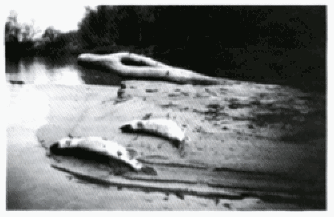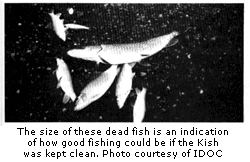
Yes, those are Northern Pike and that is the
Kishwaukee River north of Sycamore.
Editor's Note: I wrote this article in 1988 when I was publishing a monthly magazine called, "DeKalb County Magazine." It is slightly edited to put it into past tense. I thought it would be an interesting article to include in these 'archives' of history in this section.
Kishwaukee River
An Endangered Resource
By Mac McIntyre
On Wednesday, April 20, 1988, employees of Lincoln Land Hog Farm, located north of Sycamore, were working on a pipe on the farm’s retention pond. The berm wall gave way and an estimated two million gallons of hog waste spilled into the Kishwaukee River. As a result, all aquatic life down stream from the hog farm was destroyed. According to information provided by the Illinois Department of Conservation (IDOC), 37.2 miles of the river were affected and an estimated minimum of 70,000 fish were destroyed by the high concentration of ammonia found in the content of the waste material. Also destroyed were aquatic plants and insects, clams and crayfish.
The incident angered the public and those directly affected by the accident were rightfully outraged. Dr. Charlie Schelkoph, owner of Lincoln Land Farm, and well-respected veterinarian, was openly criticized for the delay in notifying officials about the accident. When employees of the farm were discovered picking up dead fish along the shorelines, accusations of a cover-up were made. Those who have known the Schelkoph family for a long period of time said they were just acting prudently, removing the fish to eliminate the strong odors and unsightly appearance of the carcasses for the sake of the neighbors.
Sadly, pollution-caused fish kills are an all-too-common occurrence on the south branch of the Kishwaukee River. In fact, from 1954-1988, as many as 19 known incidents have occurred in DeKalb County’s segment of this river. The villain is not the farmers, the industries, nor the municipal waste treatment facilities of the county, although each mentioned has been suspected of causing one or more of the fish kills. The villain is the general lack of understanding by the public as to the effect of a spill on the ecological system of the river and an inadequate system of prevention and policing.
 Had the employees of the Lincoln Land Farm known the extent of the damages that the recent spill caused to the river they may have been quicker to report the accident to the authorities. They may have done more to stop the flow of waste material into the river-if anything could have been done.
Had the employees of the Lincoln Land Farm known the extent of the damages that the recent spill caused to the river they may have been quicker to report the accident to the authorities. They may have done more to stop the flow of waste material into the river-if anything could have been done.
“Our small rivers are the most important component in providing recreational fishing in Northern Illinois,” said Peter Paladino, Region 1 Fisheries Administrator for IDOC. “The dollar value placed on the fish mortalities represents only the costs involved in replacing the estimated number of fish that are killed. This does not reflect the amount of money that is lost in terms of dollars spent by the people who use the waters for recreational purposes.”
“The south branch of the Kishwaukee River has had a history of pollution related fish kills. The Hog Farm accident is just one of too many such incidences,” continued Paladino. “Something has to be done to prevent this from happening.”
According to actual field reports of fish kills on the Kishwaukee provide by IDOC, the hardest hit segment of the river is the portion of the river that runs through the city of DeKalb. Of the 19 known fish kills that have occurred since 1954, 11 happened within the city limits.
Information contained in these reports indicate a strong correlation between several of these kills and periods of heavy canning operations at Del Monte on Taylor street in DeKalb. In September, 1984, a fish kill was investigated by IDOC officials that had affected a portion of the river from a bend north of Lucinda Avenue to Lincoln Highway. Evidence gained from testing proved that in at least this instance a faulty valve on a pipe at Del Monte was responsible for the kill. When notified of the situation officials at Del Monte were quick to take the necessary steps to prevent the mishap from happening again and issued the State a check for the estimated value of lost fish.
Finding the exact cause of a fish kill can be difficult – especially if there is a delay between the times the kill occurs and the situation is reported to officials. In fact, of the 19 post-1950 fish kills, only in three cases have officials been able to pinpoint the exact cause: The Lincoln Land Farm incident, Del Monte in 1984, and one attributed to Spalding Fibre (an accidental cesylic acid spill in March of 1974).
The Illinois Environmental Protection Agency (IEPA) and IDOC work closely together in the monitoring and investigating of pollution-related fish mortalities. Both Jack Adam, environmental protection specialist for IEPA and Peter Paladino (IDOC), agree that the most important component in preventing river pollution is public awareness of the problem.
“We need the people of DeKalb County to be on the lookout for possible pollutants entering the Kishwaukee River,” stated Jack Adam,” and most importantly, when signs of a fish kill are evident (the people should) call our emergency number right away. The sooner we are informed about the fish kill the more likely it is that we can locate the source and take the steps needed to stop it from happening again.”
 Reporting a potential or actual toxic waste entering the river does not necessarily mean that the informer will cause the party responsible for the effluent to be fined or to suffer from legal ramifications. According to Adam, “We [IEPA] like to think of ourselves as 99.9% service and .1% enforcement. If (someone responsible for accidentally polluting the river) is cooperative and takes the needed action to stop the polluting, then we will work with them and provide whatever assistance we can. If they choose not to cooperate then we will pursue any legal options that are necessary.”
Reporting a potential or actual toxic waste entering the river does not necessarily mean that the informer will cause the party responsible for the effluent to be fined or to suffer from legal ramifications. According to Adam, “We [IEPA] like to think of ourselves as 99.9% service and .1% enforcement. If (someone responsible for accidentally polluting the river) is cooperative and takes the needed action to stop the polluting, then we will work with them and provide whatever assistance we can. If they choose not to cooperate then we will pursue any legal options that are necessary.”
IDOC responded to the Lincoln Land Farm accident with unprecedented action. As soon as their biologists indicated the river was clear of harmful toxins, IDOC released 25,000 three-inch northern pike and 150 ready-to-spawn small-mouth bass into the Kishwaukee River. Extensive follow-up research and testing will be done to insure that IDOC has restocked the Kishwaukee River after a pollution-caused fish kill.
According to Peter Paladino, IDOC has plans to release another 150-220 small mouth bass later this summer. The bass are tagged for identification and research purposes. It is asked that anyone catching one of tagged bass release the fish and call IDOC at 815) 624-2968 and report the location of the fish. The northern pike are expected to reach 10’’-12’’ in length by fall and should reach legal size (24’’) in about three years. It is believed that their will be an explosion of small fish in the near future that will adequately supply food for the stocked fish. If the river is properly taken care of it should be an excellent place to fish in future years.
There is also local effort to aid in the restoration of the river. Three local fishing clubs; the Shabbona Lake Sportsman Club, DeKalb County Anglers and Northern Illinois Anglers Club, have taken the initiative to raise funds to help IDOC’s efforts to restock the river. Their goal is to raise at least $2000 as soon as possible, with all proceeds to be used exclusively for restocking the Kishwaukee River with adult-sized fish. At press time, the group, led by Dennis Sands of Shabbona, had raised $1400.
In an honorable move that even his harshest critics admitted, “took a lot of guts,” Charlie Schelkoph attended a meeting of concerned and angry citizens in Kirkland to personally donate $1000 to this effort.
With all the fish kills that have happened on the Kishwaukee River since 1954, a person could mistakenly assume that the river’s fish population could not thrive. The fact that more than 70,000 fish were killed in this most recent accident, and previous similar occurrences have taken such a high toll of fish, would seem to prove otherwise. Remember, this is the first time IDOC has restocked the Kish after such an incident. This is not to say that the river can afford more such accidents. It means that the Kishwaukee River has the ability to support a good supply of both game and non-game fish if given a chance.
The time has come for the people of DeKalb County – especially those with land, businesses or industries that are along its banks or tributaries to police themselves and protect our natural resources. Is this too much to ask in return for the millions of hours of enjoyment and recreation the Kishwaukee River has provided us?


